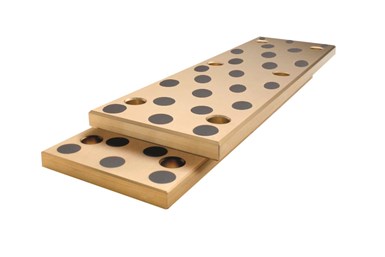Understanding Self-Lubricating Components
Recognizing that they are essentially conventional components with lubricant added in the form of graphite will help the molder realize their significant benefits.
#basics #FAQ

Although self-lubrication adds about 20 % to the cost of a conventional component, such self-lubricating components offer maintainability, reliability, simpler designs and a clean operation. Photo Credit: SelfLube Co.
Using self-lubricating mold components has significant benefits, but only if the molder truly understands what these components are: essentially a conventional component with lubricant added in the form of graphite plugs. Graphite is a solid lubricant, so, for those molders who are used to working with liquid lubricants such as grease or oil, a solid lubricant may seem a little strange, and so might the graphite itself.
Graphite has a near-zero coefficient of thermal expansion, which means that it doesn’t expand and contract with temperature changes like ordinary substances do. It’s not a metal, but it conducts electricity like one. It also doesn’t melt. Instead, it remains a solid at temperatures ranging to 10,000°F and then becomes a gas. It’s not very strong, but it can be formed into composites with incredible strength.
Featured Content
The strangest thing about graphite, however, is its molecular structure. It’s a two-dimensional crystal, and since we live in a three-dimensional world, a two-dimensional object seems to defy all logic. Graphite is one of two crystalline forms of ordinary carbon. The other is diamond, which is a conventional three-dimensional crystal, meaning it is strong in all three dimensions. Because graphite is a two-dimensional crystal, it is strong in just two dimensions.
What appears to be a solid chunk of graphite is actually a stack of very thin (one-atom-thick) crystal sheets. These thin sheets tend to slip and slide around on each other and can be easily peeled off, which turns out to be a very useful property for its use in moldmaking.
We all know that graphite makes for an excellent writing instrument. The word “graphite” comes from the Greek word grapho, which means “to write.” However, it is the same “slippery” property that’s evident when it’s used in writing that makes graphite highly useful as a lubricant as well. When you rub a pencil lead, it feels oily, although in reality, it is not oily. It is completely dry. What you are feeling is the slipping and sliding of its one-atom-thick crystal sheets. It is precisely this action that makes graphite such an excellent solid lubricant.
Features and Functions
The main function of a self-lubricating mold component is to guide and control movement. Such a mold is typically made of aluminum bronze, an excellent bearing material, with embedded graphite plugs. The mating part of the mold (the one being guided) is usually made of hardened steel. As the two parts move relative to each other, the very slippery one-atom-thick sheets of graphite peel off and become distributed over the wear surface. With each cycle, a bit more graphite is distributed, so the process continuously replenishes. Graphite doesn’t evaporate and is relatively inert, so the lubrication it imparts is essentially permanent.
Although self-lubrication adds about 20 percent to the cost of a conventional component (one that must periodically be greased), there are several benefits for this extra cost:
• Maintainability. The need for periodic greasing is eliminated, which means, over the life of the tool, the savings in preventive maintenance (PM) is likely to be several times the upfront cost for self-lubrication.
• Reliability. Lubrication is always present, eliminating the risk of failure or shortened life due to skipped PM. Also, the absence of liquid lubricants means there is nothing to attract grit and other contaminants to wear surfaces.
• Simpler designs. With self-lubricated components, there is no need to make provisions for periodic lubrication, which removes a design constraint, potentially reducing costs and/or improving functionality.
• Clean operation. No liquid lubricants to drip or spatter on parts means a very clean operation with less scrap and rework.
RELATED CONTENT
-
Advancing the Mold With New Technologies
This roundup is full of products and services that help answer concerns and meet needs for the industry. Featured in this roundup are hot runners, mold components, mold materials and more.
-
To the Next Level: Hot Runners, Mold Components Solutions and Services
Moldmaking can be a complex business, but things can be simplified with the right hot runner and mold component technologies and services.
-
Large Hybrid Steel Insert Solves Deformation, Dimensionality, Cycle Time Problems
DMLS printers using metal additive powders selected by Linear AMS to produce high-quality, accurate, consistent 3D-printed mold components with certification and traceability.
.jpg;maxWidth=970;quality=90)








.jpg;maxWidth=970;quality=90)




